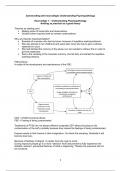Samenvatting
SAMENVATTING/SUMMARY UNDERSTANDING PSYCHOPATHOLOGY (PSB3E-KP02)
Dit document bevat een samenvatting van de zeven hoorcolleges van Understanding Psychopathology (PSB3E-KP02) inclusief informatie van de bijbehorende artikels. De samenvatting bevat gedetailleerde informatie, inclusief dikgedrukte begrippen en afbeeldingen ter verduidelijking. Zelf had ik het vak d...
[Meer zien]




